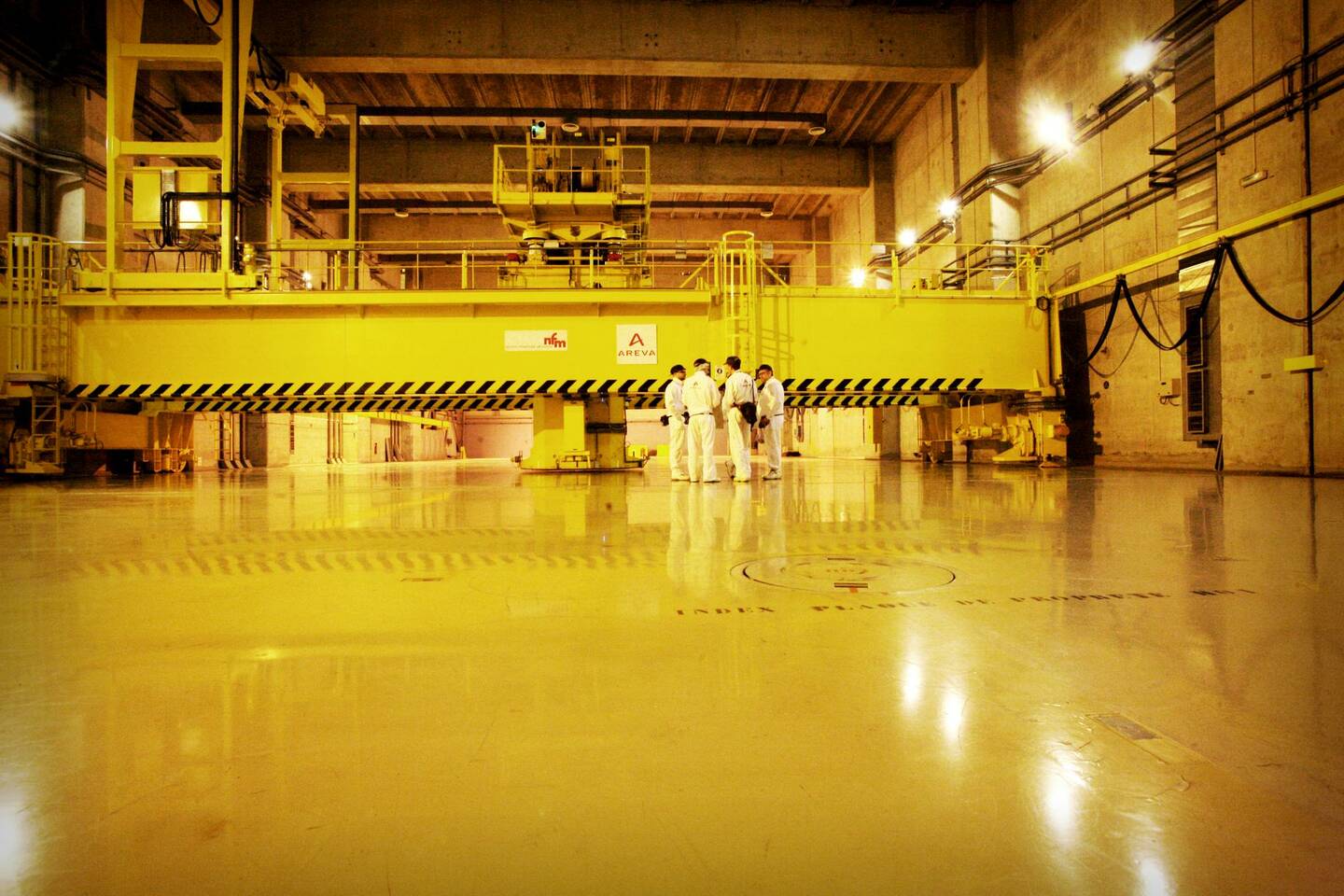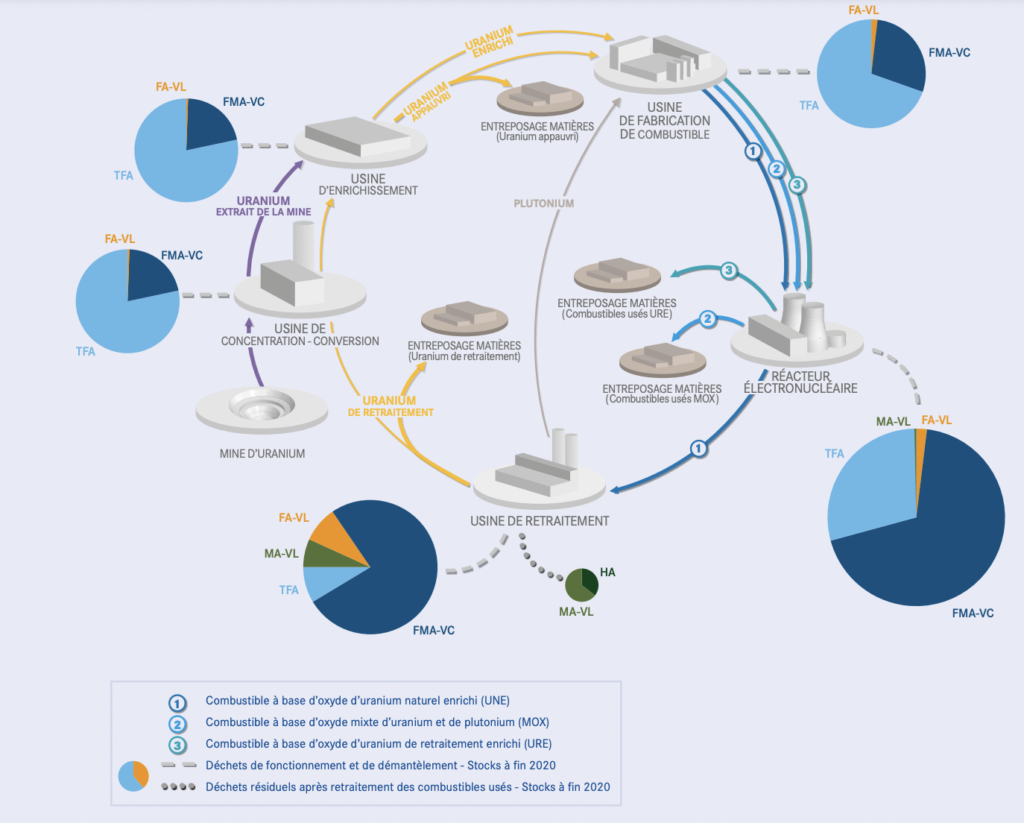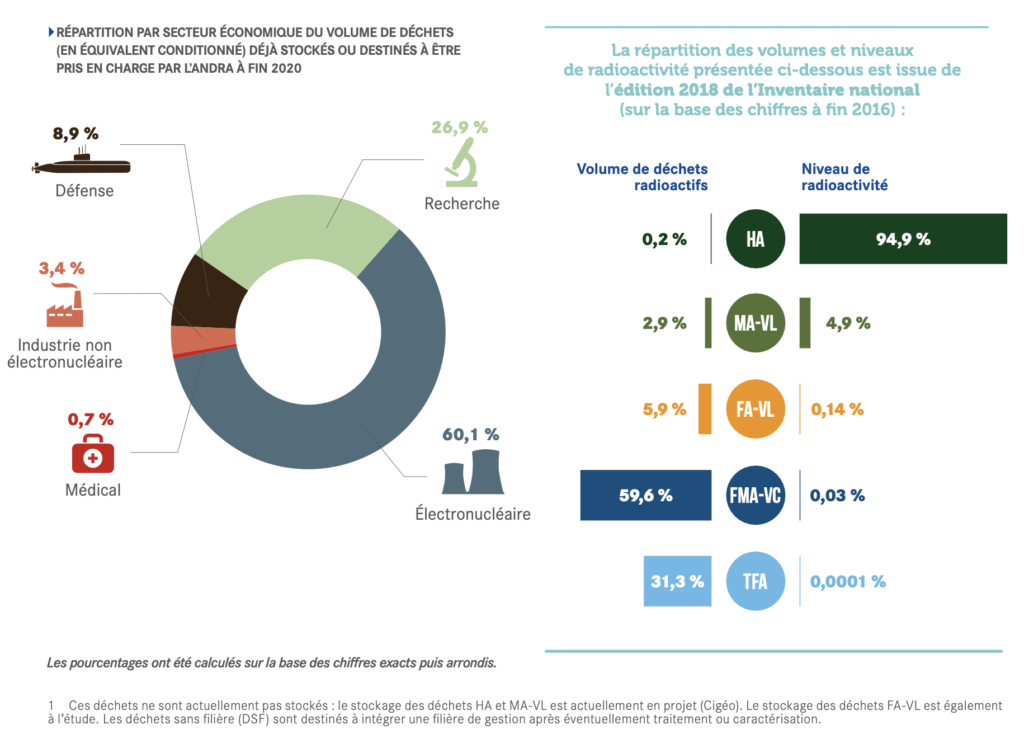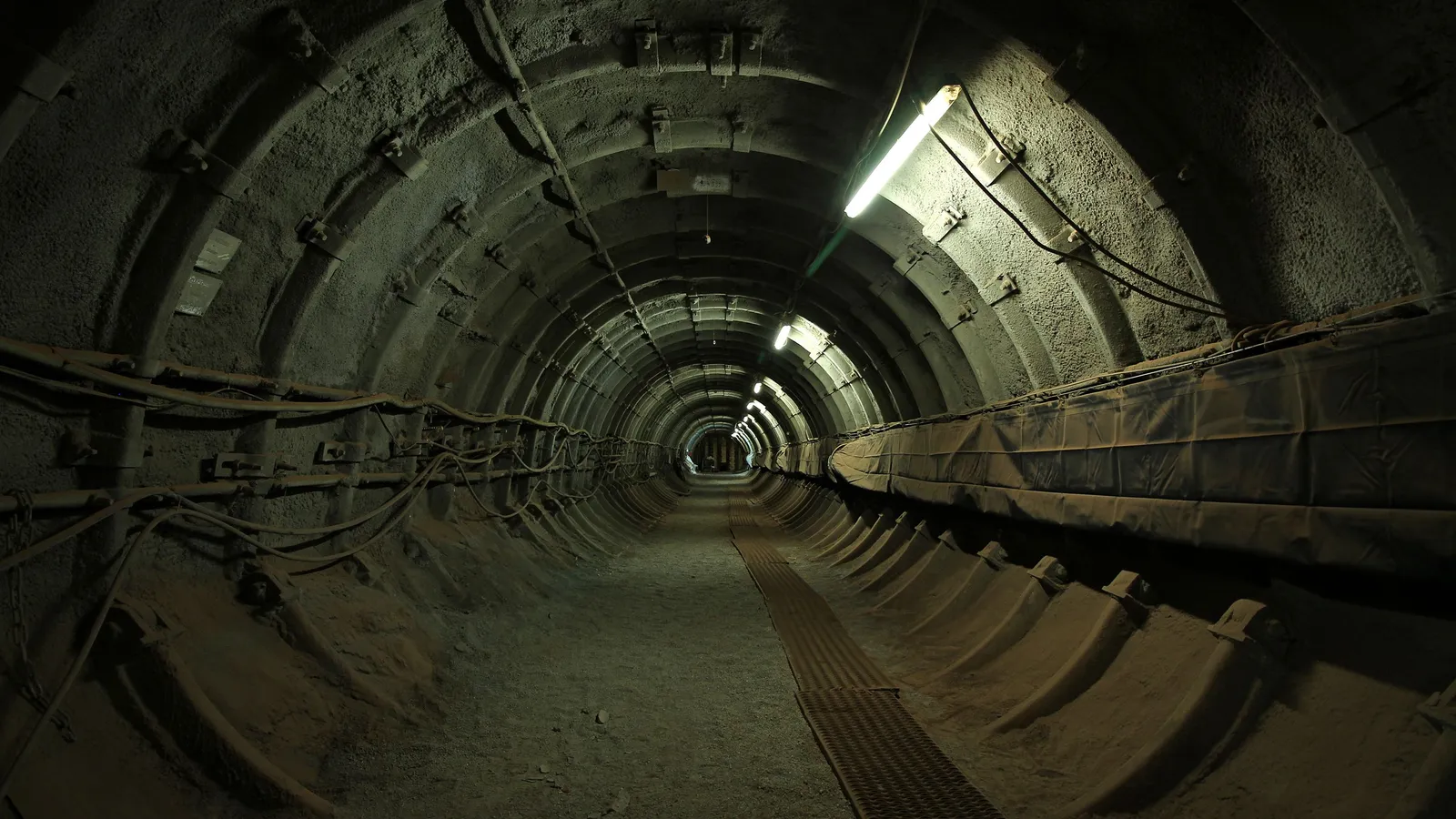
Storing facility for nuclear waste in La Hague, France. Credits: Libération.fr
Extracting uranium, converting it into fuel, and using it to power a country and destroy another are central steps of the atomic circuit. But like any processes, there always remains something to be disposed of at the end of the trail. What must be done with the residues of the the atomic circuit?
Storing the excess of the atomic circuit, whether that be from mining, construction, research, medicine, energy production, or even defense (atomic bombs), is a complicated process because of its core characteristic: waste from nuclear matter is radioactive and can therefore pose a significant risk to both the people and the environment.
Although the majority (percentage-wise) of nuclear waste, if properly taken care of, does not constitute a bigger hazard than other hazardous materials (either because of its low radioactivity or because of its short half-life, often both), a non-negligible part is extremely dangerous, particularly when derived from nuclear power plants and atomic bomb tests. As Peter C. van Wyck puts it in Signs of Danger (2009), nuclear waste upends the two rules of general waste management. Indeed, if non-radioactive waste calls for containment (storing waste at a specific location so it does not leak) and decay (disposing of waste over time), nuclear material “can neither be completely accumulated (contained), nor spent (disposed). It tends to drift” (3-4, emphasis in the original).
This drifting, in fact, is not simply spatial, but temporal too: radioactive material can spread through space for up to hundreds of thousands of years — timescales so large they disrupt our human temporal apprehensions. Nuclear waste, in that sense, must be apprehended as a threat, that is, a danger always located in the deep future and which must thus be managed accordingly, taking into account all of the geological, climatic, and human parameters that may unfold over millennia (4). To contemplate the use of atomic matters, in other words, we must always take into consideration their excesses — the waste byproducts they generate.
In our time of rapid environmental collapse, however, and despite the threat that radioactive waste poses, nuclear power is nevertheless heralded as a providential solution to curb global warming and the deleterious effects of an ecological predicament seemingly and solely reducible to carbon emissions. As Erik Swyngedouw has argued (2010), the apocalyptic narrative that dominates discussions of climate change as well as the fetishization of carbon emission have effectively kept solutions circumscribed to the techno-scientific realm within the event horizon of capitalism, thereby disavowing the political as a possibility for ecological action and engagement (220-221). This kind of positional argumentation — “technology will save us” rather than “political action will” — therefore displaces the problem rather than tackling it:
“Consider, for example, the current argument over how the nuclear option is again portrayed as a possible and realistic option to secure a sustainable energy future and as an alternative to deal both with CO2 emissions and peak-oil. The redemption of our CO2 quagmire is found in replacing the socio-ecologically excessive presence of CO2 with another socio-natural object, U235/U238, and the inevitable production of all manner of socio-natural transuranic elements. The nuclear ‘fix’ is now increasingly staged […] as one of the possible remedies to save both climate and capital.”
Swyngedouw 224-225
No other part of the atomic circuit, then, is perhaps as time-oriented as nuclear waste — that is, requiring of us foresight in the decisions that we make now. The techno-scientific solution offered by the “nuclear fix,” however, is not a real and truthful reflection on the kind of pollution that comes with radioactive waste. The problem intrinsic to that waste, in fact, encounters two caveats: is almost always minimized, and even manipulated on a definitional level first, and a historical level second.
The first concerns language. Andra, the French organization in charge of managing radioactive waste, for example, uses a semantic slight of hands, insisting that there are important differences between a nuclear waste and a nuclear matter. Quoting the French Environmental Code, Andra argues that nuclear matter is a radioactive substance that will be, or could be, reused and recycled (in French, “une substance radioactive pour laquelle une utilisation ultérieure est prévue ou envisagée”). The word choice is telling: defining a substance as having a potential ulterior use justifies cataloguing it as a nuclear matter in lieu of a waste, giving the illusion that a closed circuit could (theoretically) become reality. Andra even provides, in its yearly report, various schemas explaining this ideal situation:

While enriched and depleted uranium are indeed reused to a certain degree, this semantic difference between waste and matter becomes a legal and definitional loophole that allows for an under-evaluation of waste and risks.
Andra also insists at length on the small volume of highly radioactive and long-life waste, writing in the same report that highly radioactive waste represents only 0.2% of the total volume of nuclear waste while moderately radioactive waste represents 2.9% (p. 16). Their radioactivity, however, is alarming: though highly radioactive waste represents “only” 0.2% of the total volume, it does account for 94.9% of the total radioactivity. against 4.9% for moderately radioactive waste.

And while it might bring relief to think that moderate to high radioactive waste represent only a small fraction of the total volume (4,190 m3 and 42,900 m3 respectively across France), implying that it is more easily manageable, we must take into consideration that France does not currently have any structural long term solution to store them, as written in the footnote of the image above. In other words, whereas low to moderate (FMA-VC), low (FA-VL), and short to very short life (TFA and VTC) radioactive waste are managed and stored by sub-organizations (the CIRES and the CSA) at specific locations, France does not have the structural capacity to safely dispose of the most dangerous kinds of radioactive waste, which is, for now, either stocked where it is produced, or kept at the La Hague site while a monumental project, Cigéo, is still under construction.
Another semantic differentiation is here in effect: that of stocking (stocker) versus storing (entreposer). Although the difference may sound tenuous (after all, aren’t all stored nuclear waste also technically stocked, and vice versa?), is does matter insofar as storing highly radioactive nuclear waste in a facility not designed to permanently host this kind of waste is a dangerous gamble. This also gives an illusion of control of a substance which, by nature, easily evades our supervision.
The second caveat we must consider when we think of nuclear waste is historical, concerning the disposal of atomic tests’ remains. Indeed, though the nuclear industry seldom mentions it, the use of civil atomic energy has historically been entwined with the manufacturing of atomic bombs, particularly through the production of plutonium.1 And while plutonium can be “recycled” into a fuel for light-waster reactors (a fuel commonly referred to as Mixed oxide fuel, or MOX), this fuel can only be used once before being completely spent. Attending to the question of storing and stocking nuclear waste, then, must necessarily imply the history of atomic testing and the legacy of highly radioactive materials at the locus of these tests, predominantly situated on Indigenous lands.2
Thus, there are, across Oceania for instance, many sites where the highly radioactive remains of atomic tests continue to poison their surroundings. France is no exception: in the lagoons of Moruroa, Fangataufa, and Hao — the atolls at the center of French atomic tests in French occupied Polynesia — lie the remains of dozens of atomic tests conducted between 1966 and 1996. Multiple deep ocean immersion sites, too, are listed in the inventory of Andra but whose geographical coordinates are not communicated: that of Oscar, Novembre, and Hôtel sites where hundreds of “non-conditioned” (that is, raw) metric tons of highly radioactive waste were dumped. A similar management was practiced in Algeria where the remains of the 17 French atomic tests in the early 1960s where buried beneath the sands of the Sahara — data that is missing on Andra’s platform.
This historical entanglement remains largely ignored when matters of nuclear waste are discussed despite the risk these types of military waste pose, though we might suspect that secrecy is to blame.

A shaft in the Konrad mine in Salzgitter, Germany, reconverted into a nuclear waste repository. Credits: Chris Baraniuk.
Notes
1. Plutonium 239, a “waste” byproduct of nuclear power plants, has long been utilized in the composition of nuclear warheads. It is a byproduct in the sense that it is derived, through nuclear fission, from uranium 238. While 239Pu (as well as 240Pu, 241Pu, and 242Pu) is produced in nuclear fuel production factories, the plutonium utilized for nuclear weapons is generated in weapon-grade plants.
2. We should also acknowledge the presence of nuclear waste sites on Indigenous lands. The Hanford site, for example, one of the most radioactive waste sites in the continental United States, situated on the shored of the Columbia River, WA, continues to poison the water, the air, and the land of the Columbia basin — an area traditionally related to the Confederated Tribes of the Umatilla Indian Reservation, the Confederated Tribes and Bands of the Yakama Nation, and the Nez Perce Tribe. In Taiwan, on Orchid Island, the Tao people have long opposed the storage of highly radioactive nuclear waste on their traditional homelands, which began in the early 1980s.
Works cited
Swyngedouw, Erik. “Apocalypse Forever? Post-political Populism and the Spectre of Climate Change.” Theory, Culture & Society, vol. 27, no. 2-3 (2010): pp. 213-232.
Van Wyck, Peter C. Signs of Danger. University of Minnesota Press, 2009.